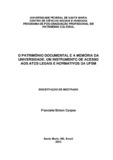| dc.creator | Carpes, Franciele Simon | |
| dc.date.accessioned | 2014-07-18 | |
| dc.date.available | 2014-07-18 | |
| dc.date.issued | 2013-06-25 | |
| dc.identifier.citation | CARPES, Franciele Simon. The documentary heritage memory and the university: an instrument of access to legal and regulatory acts of
UFSM. 2013. 163 f. Dissertação (Mestrado em História) - Universidade Federal de Santa Maria, Santa Maria, 2013. | por |
| dc.identifier.uri | http://repositorio.ufsm.br/handle/1/11018 | |
| dc.description.abstract | His paper presents a study on archival description and dissemination of the resolutions
of the Rector at Universidade Federal de Santa Maria. Due to its probative value and
informative documents resulting from legal acts and regulations of the Universidade
Federal de Santa Maria are considered permanent, i.e., they are historical documents
that make up the documentary heritage of the University. Currently, most of these
documents are accessible only on paper. Still, the number of queries is high due to the
relevance of these documents and their use for decision making. The availability of
these documents, using technological tools, would be, therefore, a greater and better
access to them. In this context, the aim of this study is the description of archival
documentary heritage of the Office of the Rector, at Universidade Federal de Santa
Maria, in order to spread their legal and normative acts. The research method chosen is
the case study, and, as instruments of data collection observation and document
analysis were used. To accomplish the description framework of standards and
standards for the development of metadata description and drawing instrument
description have been established. This standards and metadata framework was
implemented in the electronic system of the University (SIE). The collection has been
digitized and described according to Brazilian Standard Archival Description -
NOBRADE. Subsequently, the instrument was published online: a catalogue of the
Resolutions of the Rector. The catalogue facilitated the search and access to the
resolutions of the rector, that were already widely consulted documents. Being online,
the instrument allowed greater access to this body and assists in preserving the original
paper for it avoids handling. The development of this research, describing and
preserving documentary heritage is significant both for the University and for the
Archives Administration. Thus, the research contributed to the studies regarding the
archival description, the use of its standards, and the use of information technology to
provide the results of this description. | eng |
| dc.format | application/pdf | por |
| dc.language | por | por |
| dc.publisher | Universidade Federal de Santa Maria | por |
| dc.rights | Acesso Aberto | por |
| dc.subject | Patrimônio documental | por |
| dc.subject | Arquivologia | por |
| dc.subject | Descrição arquivística | por |
| dc.subject | Acesso | por |
| dc.subject | Documentary heritage | eng |
| dc.subject | Archives administration | eng |
| dc.subject | Archival description | eng |
| dc.subject | Access | eng |
| dc.title | O patrimônio documental e a memória da universidade: um instrumento de acesso aos atos legais e normativos da UFSM | por |
| dc.title.alternative | The documentary heritage memory and the university: an instrument of access to legal and regulatory acts of
UFSM | eng |
| dc.type | Dissertação | por |
| dc.description.resumo | Este trabalho apresenta um estudo sobre descrição e a difusão arquivística das
resoluções do Reitor da Universidade Federal de Santa Maria. Devido ao seu valor
probatório e informativo, os documentos decorrentes dos atos legais e normativos
da Universidade Federal de Santa Maria são considerados de caráter permanente,
ou seja, são documentos históricos, que compõe o patrimônio documental da
Universidade. Atualmente, a maioria destes documentos está acessível apenas em
suporte papel. Ainda assim, o número de consultas é elevado, devido à relevância
desses documentos e ao uso para tomada de decisões. A disponibilização destes
documentos, utilizando-se de ferramentas tecnológicas, permitiria, portanto, um
maior e melhor acesso a estes. Neste contexto, o objetivo deste estudo consiste
na descrição do patrimônio documental arquivístico do Gabinete do Reitor, da
Universidade Federal de Santa Maria, a fim de difundir os seus atos legais e
normativos. O método de investigação escolhido é o estudo de caso, e como
instrumentos de coleta de dados, foram utilizadas a observação e a análise
documental. Para realizar a descrição foi estabelecido o quadro de padrões,
normas e metadados para o desenvolvimento da descrição e elaboração do
instrumento de descrição. Esse quadro de padrões e metadados foi implementado
no sistema eletrônico da Universidade (SIE). O acervo foi digitalizado e descrito
conforme a Norma Brasileira de Descrição Arquivística NOBRADE.
Posteriormente, publicou-se o instrumento online: um catálogo das Resoluções do
Reitor. O catálogo facilitou a busca e o acesso às resoluções do reitor, que já eram
documentos muito consultados. Por ser online, o instrumento possibilitou maior
acesso a este acervo e auxilia na preservação do original em suporte papel, pois
evita o seu manuseio. O desenvolvimento desta pesquisa, descrevendo e
preservando o patrimônio documental, é significativo tanto para a Universidade
como para a Arquivologia. Dessa forma, a pesquisa contribuiu para os estudos
quanto à Descrição Arquivística, o emprego de suas normas, e a utilização da
tecnologia da informação para disponibilizar o resultado desta descrição. | por |
| dc.contributor.advisor1 | Flores, Daniel | |
| dc.contributor.advisor1Lattes | http://lattes.cnpq.br/9640543272532398 | por |
| dc.contributor.referee1 | Cordenonsi, Andre Zanki | |
| dc.contributor.referee1Lattes | http://lattes.cnpq.br/4311327191424332 | por |
| dc.contributor.referee2 | Konrad, Glaucia Vieira Ramos | |
| dc.contributor.referee2Lattes | http://lattes.cnpq.br/1194002753412760 | por |
| dc.creator.Lattes | http://lattes.cnpq.br/9716997139724273 | por |
| dc.publisher.country | BR | por |
| dc.publisher.department | História | por |
| dc.publisher.initials | UFSM | por |
| dc.publisher.program | Programa de Pós-Graduação em Patrimônio Cultural | por |
| dc.subject.cnpq | CNPQ::CIENCIAS HUMANAS::HISTORIA | por |


